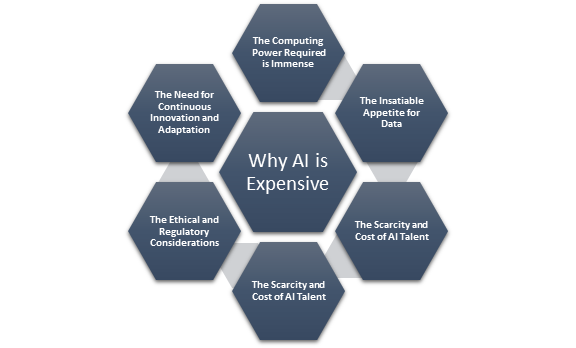
The High Costs of Developing Advanced Artificial Intelligence
As artificial intelligence (AI) advances, developing and implementing cutting-edge technologies have become increasingly expensive.
While AI offers immense potential benefits across many industries, the truth is that only companies and organizations with considerable resources are able to truly capitalize on AI due to the high costs involved.
1. The Computing Power Required is Immense
At the core of any advanced AI system is the need for tremendous computing power. Training large language models or deep learning systems for computer vision, for example, requires processing vast amounts of data across specialized hardware like graphics processing units (GPUs) and tensor processing units (TPUs). This intense computation is not only expensive in terms of the hardware itself but also incurs significant energy costs.
Training OpenAI's GPT-3 language model, for instance, is estimated to have cost millions of dollars due to the immense computing resources required. Google's PaLM model was trained using sophisticated AI clusters. Such cutting-edge hardware setups can cost tens of millions of dollars to build and maintain.
But the costs don't end after training. Deploying and running AI models at scale for real-world applications also demands substantial computing infrastructure, whether on-premises or through cloud services. The ongoing operational costs of provisioning sufficient compute, storage, and networking resources can quickly become exorbitant for companies trying to integrate AI capabilities into their products and services.
2. The Insatiable Appetite for Data
Another major expense associated with AI is the immense volume of data required to train accurate and capable models. Contemporary AI systems are heavily dependent on vast datasets to learn patterns and gain proficiency. For example, language models ingest billions or even trillions of words from the internet and books to understand the intricacies of human language.
However, acquiring, cleaning, annotating, and maintaining such enormous datasets is an extremely laborious and costly process. Companies often need to employ armies of human annotators or crowdsource the work to properly label data for AI training. Errors or biases in the data can also significantly degrade the AI model's performance, necessitating additional data processing efforts.
The costs of acquiring quality data can easily run into the millions or even billions of dollars for large-scale AI initiatives. Moreover, as AI systems become more advanced and versatile, the appetite for data will only continue to grow, further driving up expenses.
3. The Scarcity and Cost of AI Talent
Perhaps the most significant bottleneck and cost driver in AI development is the shortage of highly skilled AI experts and engineers. With AI rapidly advancing and being adopted across numerous industries, the demand for professionals with specialized skills in areas like machine learning, deep learning, natural language processing, and computer vision has skyrocketed.
However, the supply of such AI talent remains severely constrained. Top AI researchers and engineers are often recruited by major tech giants like Google, Microsoft, and Meta, which can offer highly lucrative compensation packages and unparalleled resources for cutting-edge research. This intense competition for talent has driven salaries for AI experts to exorbitant levels, with some earning well into the millions.
Moreover, it's not just about hiring skilled individuals; companies must also invest heavily in training and retaining their AI workforce. Continuously upskilling employees to keep pace with the rapid evolution of AI techniques and tools is essential but comes at a significant cost.
Acquiring and maintaining a world-class AI team capable of pushing the boundaries of innovation can easily account for a substantial portion of the overall AI development budget for many organizations.
4. The Complexity of AI System Development
Building advanced AI systems is an incredibly complex and multifaceted endeavor, requiring expertise across numerous disciplines and domains. It's not just about having skilled AI researchers and engineers; successful AI projects also necessitate collaboration with subject matter experts, domain specialists, data scientists, software developers, and others.
Moreover, developing AI systems involves numerous intricate stages, each with its own set of challenges and costs. From data acquisition and preparation to model training, evaluation, and deployment, every step of the AI development lifecycle requires significant resources, specialized tools, and rigorous testing.
The complexity only increases when integrating AI capabilities into existing systems and workflows, as organizations must ensure seamless interoperability, robust security measures, and compliance with various regulations.
Furthermore, the iterative nature of AI development means that costs can quickly spiral as models undergo multiple cycles of training, testing, and refinement before being production-ready. This iterative process, while essential for achieving high-performance AI, significantly increases the overall development time and associated expenses.
5. The Ethical and Regulatory Considerations
As AI systems become more powerful and ubiquitous, there is a growing emphasis on addressing the ethical implications and potential risks associated with these technologies. Ensuring AI systems are fair, unbiased, transparent, and aligned with societal values is crucial but also adds an additional layer of complexity and cost.
Organizations must invest in developing robust ethical AI frameworks, implementing appropriate governance structures, and conducting rigorous testing to identify and mitigate potential biases or discriminatory outcomes. This often involves employing specialized ethicists, legal experts, and third-party auditors to evaluate the AI systems and provide guidance.
Additionally, as AI regulations continue to evolve globally, companies must allocate resources to ensure compliance with various laws and guidelines governing the development, deployment, and use of AI technologies. Failure to adhere to these regulations can result in significant fines, legal liabilities, and reputational damage.
Meeting these ethical and regulatory requirements can add substantial costs to AI initiatives, but it is an essential investment to ensure the responsible and trustworthy development of AI systems.
6. The Need for Continuous Innovation and Adaptation
The field of AI is constantly evolving, with new techniques, architectures, and approaches emerging at a rapid pace. What was considered cutting-edge just a few years ago may quickly become outdated, and organizations must continuously invest in research and development to stay ahead of the curve.
Adapting to these advancements often requires significant resources for retraining AI models, upgrading hardware and software infrastructure, and upskilling personnel. Companies that fail to keep up with the latest AI innovations risk falling behind competitors and missing out on potential opportunities.
Moreover, as AI systems become more advanced and capable, their computational requirements and data needs will likely continue to grow exponentially, further driving up costs. Maintaining a competitive edge in AI requires a sustained commitment to innovation and a willingness to invest heavily in staying at the forefront of this rapidly evolving field.
Last Word!
While the potential benefits of AI are immense, the costs associated with developing and implementing advanced AI systems are equally substantial. From the immense computing power and data requirements to the scarcity of top AI talent and the complexity of system development, organizations must be prepared to invest significant resources to truly capitalize on the power of AI.
Moreover, the ethical and regulatory considerations, as well as the need for continuous innovation and adaptation, further compound the expenses involved in AI initiatives. As AI continues to evolve and become more deeply embedded in various industries, these costs are likely to increase further, solidifying AI as an expensive but potentially transformative technology.
Ultimately, the high costs of AI development serve as a barrier to entry, limiting widespread adoption to only those organizations with substantial resources and a long-term commitment to investing in this cutting-edge field. However, for those willing and able to make the necessary investments, the potential rewards of AI could be game-changing, driving innovation, productivity, and competitive advantages across industries.
Trending
-
1 SEO Mistakes That Could Be Costing Your Shopify Store Sales
Daniel Hall -
2 Strategies for Safeguarding Assets and Investments
Daniel Hall -
3 The Role of PR Firms in Crisis Management and Damage Control
Nitish Mathur -
4 How to Make Appealing Visuals for Your E-commerce Store
Daniel Hall -
5 The Competitive Landscape of Low-Cost Carriers in Belgium: TUI Fly Belgium’s Position
Daniel Hall






Comments